This post has been read 6148 times!
 September 4, 2016- After several years of having no hurricanes develop off of the African Coast, we are getting hit again. However, four years after Hurricane Sandy, the incompetent New York establishment government, which wants Hillary Clinton to become president, has done nothing to prevent flooding of the tunnels and subways as Hurricane Hermine heads our way.
September 4, 2016- After several years of having no hurricanes develop off of the African Coast, we are getting hit again. However, four years after Hurricane Sandy, the incompetent New York establishment government, which wants Hillary Clinton to become president, has done nothing to prevent flooding of the tunnels and subways as Hurricane Hermine heads our way.
The best the city can do is overreact, close down things, and sandbag the subways entrances, which will do nothing.
(FYI, Hermine will not hit the Northeast. Just follow the NASA images and ignore TV.)
Opinion Update November 15, 2012
BatteryPark.TV was the first to point out (below) that much of the human suffering after Hurricane Sandy was preventable and due to institutional incompetence. We caught a lot of flack for this. For example, the executive producer for the “CBS This Morning” show replied on Twitter that we were delusional and out of touch with the severity of the storm.
It now seems that Governor Cuomo agrees with our early assessment. He is publicly berating the Long Island power utility, LIPA. Other news reports have listed the shortfallings of Consolidated Edison and the MTA as well.
Hurricane Sandy was a strong storm farther to the south, but when it hit New York it was a “post tropical storm” with low winds and little rain. Nevertheless, massive damage was done to coastal areas of Staten Island, Long Island, and the lower east side of Manhattan when a modest storm surge of flooding wiped out power and phone service. Those services should have been more resilient and repaired faster, according to the governor and numerous other sources.
Despite charging one of the highest rates for electricity on the country, LIPA has provided the worst service. Criminal investigations should ensue and major restructuring of labor contracts should result.
November 1, 2012 By Steven E. Greer, MD
I am sitting in my Ivory Tower apartment 500 feet in the sky overlooking a calm New York Harbor in front of me and the Financial District (FiDi) to me left. It is now almost three full days since the storm surge of Hurricane Sandy caused a brief period of minor flooding confined to Lower Manhattan. I use the word “minor” as comparison to typical hurricanes in the south, and to what they experienced after Hurricane Katrina.
My Verizon landline phone is still out of service despite the global headquarters being located about a mile up the street. My AT&T cell phone has spotty service. My Verizon Internet only returned to function yesterday. But I have it made in the shade compared to my fellow humans to my left in FiDi.
Across the West Side Highway, at night, the despair is visible. They have no power in FiDi, Lower East Side, and Tribeca. The subways are full of billions of gallons of water. Nothing is working and the electronic refugees are starting to trek over to Battery Park to find any public space with electrical outlets. Yesterday, they numbered in the hundreds sitting on the floor of the World Financial center atrium and in any restaurant that was open. Today, they will be in the thousands. Tomorrow, tens of thousands will be going to desperate measures to find basic services.
Wealthy professionals in Tribeca who own multi-million dollar apartments are essentially homeless. I saw one man setting up his full PC computer on the floor of the WFC.
There is a brewing humanitarian crisis days after the hurricane that is eerily reminiscent of Katrina. Recall, it was not until the levees broke that Katrina became the multi-year disaster that it was.
The images seen on TV of epic destruction are not of Manhattan. Why is the biggest city in the country, the financial capital of the world, completely disabled many days after a minor storm (that hit Manhattan, but was far worse in New Jersey) that caused only two hours of flooding? Manmade institutions are to blame.
The Metropolitan Transit Authority (MTA) has mismanaged the New York public transit for many decades. Every person who visits Europe, Japan, China, and other countries realizes that New York City is a Third World country when it comes to the subways. There is no reason that a few feet of flooding with low winds should have shut down the subways for what will likely be weeks.
The hardest hit subway station that has been shown on TV the most is by the Staten Island Ferry stop. In an interview with ABC’s Chris Cuomo, an MTA official explained that they used plywood to board up the entrance, and that the weak attempts were smashed by the water. Being at sea level, why was this subway entrance designed without flood gates? Nearby, the Goldman Sachs building has flood gates and was kept dry.
Likewise, up the West Side Highway, which was a river during high tide on Monday night, the Verizon headquarters was under water. Verizon is a quasi-public-utility far less accountable than a fully private company. Why did they not have back up redundant systems to prevent massive Internet and phone outages? Being so close to Ground Zero, there seems to have been no lesson learned to create backup systems in remote areas.
On Wall Street, the New York Stock Exchange was shut down for two days, with ripple effects to the global markets. Did the NYSE really learn anything from 9/11? Generators did not kick in until Wednesday. Why did not the NYSE have a backup trading floor in Jersey City?
The dangling construction crane 1,000 feet above West 57th Street was operated by a company with numerous criminal prosecutions. Lend Lease executives barely escaped jail 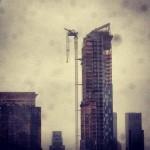 time after their demolition crew tearing down the old Deutsche Bank building on Ground Zero caught fire and two NYFD firefighters were killed. Early reports indicate possible human error caused the crane to not be set to swivel freely during high winds.
time after their demolition crew tearing down the old Deutsche Bank building on Ground Zero caught fire and two NYFD firefighters were killed. Early reports indicate possible human error caused the crane to not be set to swivel freely during high winds.
The evacuation of NYU Hospital and then of nearby Bellevue were disgraces of those historic institutions. Everyone from the people in charge of the generators to the CEO should lose their jobs. Critically ill patients and neonates were carried down stairs into ambulances and transferred to Mount Sinai. The investigations into this will surely lead to malfeasance and incompetence. Did they learn nothing from the hospital disasters after Hurricane Katrina that led to elderly being euthanasized by panicking nurses and doctors?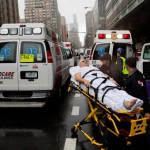
Consolidated Edison (conEd) seems negligent on many levels as well. The biggest residential fire in modern times destroyed more than 100 homes in Rockaway after a gas fire erupted. Why were not gas lines turned off at this sea level community sure to take the worst of Hurricane Sandy? In Manhattan, the biggest crisis of 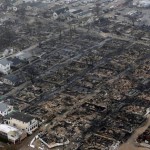 the hurricane has been caused by the power outages that have no end in sight. Decades of poor planning and bureaucracy of this utility led to unsafe underground electrical infrastructure despite billions being pumped into renovating Downtown after 9/11.
the hurricane has been caused by the power outages that have no end in sight. Decades of poor planning and bureaucracy of this utility led to unsafe underground electrical infrastructure despite billions being pumped into renovating Downtown after 9/11.
Billions of people are watching video news of this catastrophe to hit the Tri-Sate area and are lumping Manhattan in with the images of the decimated Jersey Shore. In reality, Lower Manhattan suffered brief flooding that lasted approximately two hours on Monday night. New York City should not have been brought to its knees for weeks by this level of assault. Major reforms of our public institutions should come of this.

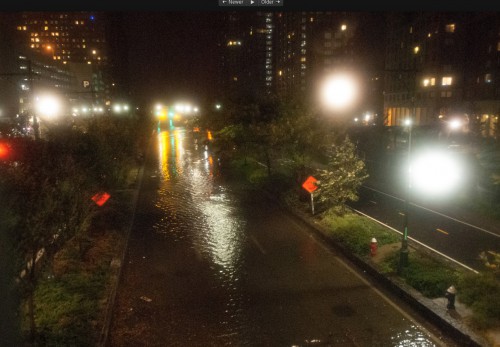
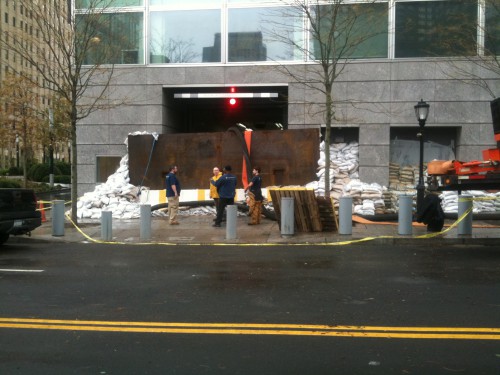
This is a good report and perspective. The infrastructure in NYC needs a major upgrade. It is an interesting view considering the GOP wants everything to be done by private enterprise. Private sector will never build the infrastructure needed.
I hope the city considers a set of flood gates by the Verrazanno bridge and NYC mouth of the Long Island Sound. This is a very practical solution which other cities have completed. London has such a system at the mouth of the Thames. Holland has such gates and a few other cities.
The costs spent addressing every building and facility would likely be larger than a single public works project.
This is – I think – your best editorial. Fine work.
Mike
excellent article — and reporting free of hype. keep up the good work.
Hi, I am writing from Germany, but my son lives in Gateway. Your article today confirmed the impression I got on my frequent visits to my son and his family. By the way: apparently the pumps in the Battery-Brooklyn tunnel are the original 60 year old machines. They can only be used to pump out rain water, but are insufficient for see water!
Regards,
David Wilchfort Doctor of Medicine/Univ. Toronto (Can)
excellent reporting with open-ended questions only the voice of voters can change!! thanks!!
I work in Media Relations for Con Edison and just read this piece alleging incompetence. The article contains serious errors of fact. Here are a few:
1. Con Edison does not serve the Rockaway Peninsula.
2. The story refers to “minor flooding” and a “modest storm surge of flooding” in Lower Manhattan. Sandy’s storm tide at the Battery (the lower tip of Manhattan) reached 14 feet, a record. The previous high was just over 11 feet during a hurricane in 1821. This was not “minor flooding” or “a modest storm surge.”
3. The flooding was also not “brief,” as the story claims. It took several days to pump millions of gallons of water out of our underground facilities.
4. The portion of the story that appears to have been written on Nov. 1, 2012 says: “In Manhattan, the biggest crisis of the hurricane has been caused by power outages that have no end in sight.” Con Edison announced on Oct. 30 – the day after the storm – that power would be back on in Manhattan during the coming weekend. We achieved that goal. It is incorrect that there was no end in sight. The “end” had already been publicly announced and reported by numerous media outlets. In fact, on Oct. 31 we announced that we had already restored power to 2,000 Manhattan customers.
We welcome your input, but some of your comments are factually incorrect.
Item #2 BPC was indeed unscathed and suffered minor flooding. The storm surge that hit the rest of the city indeed only lasted a few hours and receded with the tide. It was not a case of flooding, for example, seen along the Mississippi River where the water lingers for days.
Item #3 is absurd. ConEd power was out for months in some areas, and was out for many days all over. LIPA and ConEd were widely blamed.
Con Edison power was not out for months in any area. In Manhattan, restoration was complete the weekend after the storm. Some customers were out of power after that date because their own electrical equipment was damaged by the flooding and needed to be repaired. The completion of our restoration was widely reported in the press at the time, as was the damage to customers’ electrical equipment.
On item 2, I was responding to your story’s claim that Sandy brought “a brief period of minor flooding confined to Lower Manhattan.” Perhaps we disagree on what constitutes “minor flooding.” But we’ve all seen photos of vehicles nearly submerged and water rushing fiercely into subway stations.
From a utility perspective, an unprecedented deluge of salt water made contact with our electrical-delivery equipment and caused massive damage. Damage to the equipment occurs at the time of contact and regardless of whether the water recedes in hours (as opposed to days).